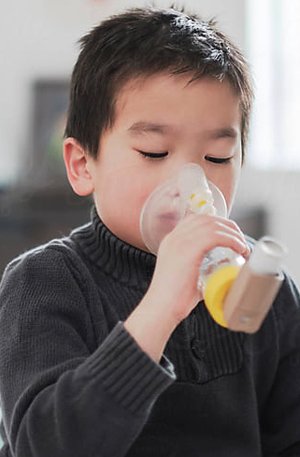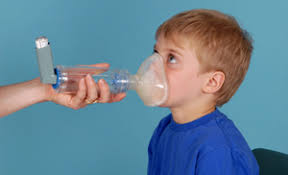Asthma in Children & Babies: Things You Should Know
Contributed by: Dr Dave Ong

What is Childhood Asthma?
Asthma is a chronic inflammatory disorder of the airways, which causes the airways to be very sensitive and prone to constriction. It is one of the most common chronic illnesses in children and can affect as many as 20% of children. Learn more about the causes and triggers of childhood asthma.Why Are More Children Getting Asthma?
It is unclear why there is an increasing number of children with asthma. Many suggest that, with a cleaner environment, the general population’s immunity is being shifted towards being more allergic. Some also suggest that children are having increasing exposure to cigarette smoke and dust, thus contributing to development of sensitive airways.What Happens During an Asthma Attack?
During an asthma attack, the sensitive airways, upon exposure to triggers such as a common cold, smoke and dust mites, will become more inflammed, resulting in airway constriction and production of more mucus, leading to further airway narrowing. This narrowing of airways results in wheezing, coughing, chest tightness and breathing difficulties for the patient. Although the airway inflamation is worsened during an asthma attack, it is often ongoing at baseline when the child has no symptoms. Thus, asthma is a chronic condition which requires proper treatment and monitoring, and not just a one-off problem.Signs and Symptoms of Asthma in Children
Here are some of the symptoms of asthma in kids.- Chronic/persistent cough, especially late at night, early morning or during exercise. It is often not known that chronic cough can be the only feature in a child with asthma.
- Breathing difficulties with reduced stamina
- Wheezing
Causes of Asthma Attacks in Children
Some possible triggers of asthma attacks in children include:- Viral upper respiratory tract infections
- Cigarette smoke (both active and passive) and haze
- House dust mites, animal dander, pollen and indoor mould
- Changes in temperature or humidity
- Psychological stress
- Certain medications (e.g. beta-blockers, non-steroidal anti-inflammatory drugs)
Diagnosis of Asthma in Children and Babies
It is unusual to diagnose asthma in infants (less than 1 year of age) as other more serious diagnoses (e.g. congenital airway abnormalities, heart defects) need to be properly excluded first. However, in older children, asthma can be more easily picked up by your child’s paediatrician based on your child’s medical history and physical examination.Your child’s paediatrician will need to explore in detail the symptoms of your child, such as chest tightness, wheezing, cough and shortness of breath. If these symptoms are recurring and tend to occur in the late night/early morning or after exercise, and are relieved by bronchodilators (such as Salbutamol/Ventolin), then it is very likely that your child has asthma. The risk factors for asthma will also be important, such as a family history of asthma or allergies, and a personal history of allergic conditions such as eczema (sensitive skin) and allergic rhinitis (sensitive nose)
Your child’s paediatrician will need to examine your child’s respiratory and cardiovascular system, and assess other aspects of his well-being such as growth, development and nutritional status.
- Lung function tests help in the diagnosis of asthma and in assessing its severity. Generally, children younger than 5 years are unable to perform pulmonary function tests reliably. Thus, history and physical examination are of paramount importance in making the diagnosis.
- Exhaled nitric oxide measurements are used to determine severity of airway inflammation in asthma, and helps in supporting the diagnosis in cases which are less clear-cut. Again, children younger than 5 years generally unable to perform this test reliably.
- Skin prick tests or blood tests may also be ordered to help identify particular allergens which may trigger asthma.
- A chest X-ray or other scans may be required if the diagnosis of asthma is not certain, especially in infants less than 1 years of age.
Treatment and Management of Asthma in Children and Babies
The goals of asthma treatment are to control all asthma symptoms, prevent asthma attacks and allow your child to lead a healthy and normal life.
An asthma action plan by your child’s paediatrician will be important in teaching you and your child how and when to use the asthma medications, and what to do in emergencies.
There should also be environmental modifications such as avoidance of smoke and house dust mites.
Medications Used to Treat Asthma in Children and Babies
There are two main groups of asthma medicine, relievers and controllers/preventers.Relievers work quickly to open up airways during an asthma attack, thus allowing your child to reverse his/her breathing difficulties or bad cough. They are to be used only for short periods when needed, such as during asthma attacks or when the asthma is uncontrolled and causing significant symptoms affecting sleep or play. It is incorrect and unsafe to rely completely on regular usage of these relievers, and patients often get confused about its role as a reliever (thinking that it is the cure for their asthma).
Controllers/preventers are slower acting medicines which control the chronic airway inflammation, making them less sensitive to triggers, thus targeting the underlying disease process in asthma. These medicines MUST be used every single day (regardless of whether the child is having symptoms or an attack or not) if prescribed by the doctor and should only be stopped or reduced when advised by the doctor. The period of treatment can range from many months to years, depending on your child’s response. It is incorrect and unsafe to stop the controllers/preventers on your own because it may result worsening of the asthma control, causing more frequent and severe attacks or symptoms. Patients also often get confused about its role as a controller/preventer (thinking that they do not work, because they do not get immediate symptomatic relief from them).
Other Medications Used For Acute Asthma Attacks
All children with asthma will be prescribed with a reliever medicine for use during asthma attacks or when the asthma symptoms are not controlled. Many children whose asthma is not well controlled may need to use a controller/preventer medicine daily. It is of paramount importance to be strictly compliant with the controller/preventer prescribed. During acute asthma attacks, there are other medications that are commonly prescribed, including a short course (3-5 days) of oral steroids to help reduce the severe airway inflammation during attacks. These must be completed according to the prescription. A short course of oral steroids does not cause long-term side effects and does not need to be tailed down. Your child’s usual controllers/preventers does not help during acute asthma attacks – its role is more for achieving longer-term control.How to Give Asthma Medication to Children?

Your child’s asthma medications can be administered with a space chamber device (with or without a mask, depending on your child’s age and ability to cooperate) or a nebulizer machine. Your child’s paediatrician will be able to advise on the suitability of each option, depending on the situation.
How Do I Use the Space Chamber With A Mask to Administer the Inhaler Puffs to My Baby/Child?
| Proper Metered-Dose Inhaler/Spacer Technique | |
| Action | Comment |
|
|
|
|
|
|
|
|
|
|
|
|
|
|
Caring Tips For Children’s Inhaler and Spacer
- Wash the spacer once every two weeks by soaking the spacer for 15 minutes in a container of water with a few drops of dishwashing liquid added.
- Do not scrub or wipe the inside of the spacer, as that would introduce electrostatic charges on the inner wall, which would decrease delivery of the medications to the patient’s airways.
- If there is a need for urgent usage of the spacer before it is dry after washing, dry it quickly with an air dryer and then prime the spacer by giving 10 puffs of reliever medications into the chamber.
What To Do When A Child Gets An Asthma Attack?
- Administer his/her reliever medicine according to the asthma action plan.
- Wait for 10 mins. If the symptoms resolve, then you can observe at home. If symptoms are not relieved, follow your child’s asthma action plan for further instructions. If your child’s condition does not improve or gets worse, or if you are unsure what to do, consult your child’s paediatrician urgently.
Children with asthma often have symptoms at school, so it is very important to get the school involved in caring for your child’s asthma. This is true even if your child has only a mild case of asthma or if he or she does not need to take asthma medicines while at school. Most schools have several children with asthma, so teachers should be familiar with helping children with asthma. Still, it is important to take steps to ensure that your child gets adequate attention and that all relevant school personnel are familiar with what is needed to help your child. You can look at this in two ways: there are things you need to do to prevent your child from having an asthma attack at school, and there are things you need to do to make sure that your child gets the right treatment if an asthma attack occurs at school.
How to Keep Asthma in Children and Babies Under Control?
Here are some of the things you can do to keep your children away from asthma attacks.- Do not expose your child to second hand cigarette smoke and keep your child away from cigarette smoke-filled environments at all times.
- Reduce the level of house dust mites. Wash bedsheets, pillow covers, and curtains in hot water (60 deg C) every 2 weeks. Avoid stuffed toys, thick curtains and carpets in the home.
- Ensure that your child gets influenza vaccination annually. Do note that this only reduces the risk of influenza infection (i.e. the “flu”), but not the numerous other common cold viruses (which do not have specific vaccinations of their own).
- If your child has allergic rhinitis (hay fever, sensitive nose), it must be treated accordingly because poorly controlled allergic rhinitis can worsen asthma control.
- Avoid giving your child cold drinks and citrus fruits when unwell with asthma attack or flu symptoms.
Managing Your Children’s Asthma in School
The most important thing is to talk to your child and, depending on how old he or she is, explain as much about the disease that your child will understand. Ideally, your child should also:
- Keep track of when it is time to take the medicine.
- Know how to use the inhaler properly.
School officials should know about your child’s asthma, including:
- How severe it is
- What the triggers are
- What medications to use and how to properly give them
- What to do in case of an asthma attack
Write up and a list and distribute it to every school official who may be caring for your child. If possible, you should try to arrange a meeting with the school officials and explain the triggers, severity, symptoms, and treatment of your child’s asthma. You should look at your child’s classroom and other areas where he or she goes in school to see if there are any triggers. If you identify possible triggers for your child’s asthma (dust mites and dust are common triggers in a classroom), you should work with the teacher to reduce your child’s exposure to these triggers.
- Class teacher: As he/she will be spending the most time with your child at school, there is a high likelihood of him/her being around during a case of an asthma attack. Explain each medication in detail with specific instructions as given by your paediatrician.
- Physical education (PE) teacher: Since exercise can trigger asthma, the PE teacher has an important role to play in keeping an extra eye on your child while exercising or playing sports.
- School principal
In addition to the above, the more teachers and other adults at school who know about your child’s asthma, the better. Your child could have an asthma attack while at lunch or in the hallway; these are places where the class teacher may not be present.
The school should have a clear set of instructions (your doctor can help with this) about what symptoms it should look out for, and what treatment it should give, where there is an asthma attack. The school should have a clear idea of what to do and when to call 995.
Should Children with Asthma Avoid Exercise or Physical Activities?
The child should avoid exercise or physical activities during and soon after an asthma attack. Many children improve, in terms of asthma control, as they get older. Once asthma is properly controlled, your child should be encouraged to take part in all usual activities. There is no need to restrict activity. With the right medication and care, children with asthma should be able to participate in sports and lead normal active lives. Many outstanding athletes have won Olympics medals despite having asthma.How To Know If Your Child’s Asthma is Well-Controlled?
Your child’s asthma would be considered well controlled if, with or without medications, your child:- Leads a normal life with normal physical activities
- Has no symptoms such as cough, chest tightness, wheezing or shortness of breath
- Has no attacks or urgent doctor visits
- Does not have to take medical leave from school due to asthma symptoms
- Has few or no medication side effects.
Can Asthma Be Cured?
Will my child’s asthma go away or be cured? Once a person’s airways become sensitive, they generally remain that way for life. However, about half of children experience a noticeable decrease in asthma symptoms by the time they become adolescents, therefore appearing to have “outgrown” their asthma. But, about half of these children will develop symptoms again in their 30s and/or 40s. Unfortunately, there is no way to predict whose symptoms will decrease during adolescence and whose will return later in life. Nonetheless, it is very important to manage your child’s asthma properly and achieve good control as soon as possible, as this will help your child breath better and improve his/her quality of life, and it may potentially reduce the risk of asthma persisting into adulthood (as some studies have shown).SUMMARY
Asthma is a common chronic illness in children, affecting as many as 20% of children. Frequent coughing spells, breathlessness or chest tightness are symptoms of asthma; however not all wheezing or coughing is caused solely by asthma. Asthma attacks may be triggered by a variety of factors, including the environment, viruses, weather or allergens. It is important to identify and avoid your child’s asthma triggers as much as possible. Asthma is usually difficult to diagnose in infants below 1 year. In older children, asthma can be diagnosed through a detailed medical history, physical examination or series of tests. Based on your child’s history and condition, your paediatrician should develop an “asthma action plan” to outline when and how your child should use medication such as relievers and controllers/preventers. Get your child’s school involved in caring for your child’s asthma – including identifying possible triggers and informing teachers of your child’s condition.About Author
This article is written by Dr Dave Ong, who completed his MBBS in the National University of Singapore (NUS) in 2009. He received his post-graduate specialist training in Paediatric Medicine at the National University Health System (NUHS) and was awarded the combined Master of Medicine (Paediatric Medicine) and Membership of Royal College of Paediatrics and Child Health (MRCPCH, United Kingdom) in 2014. Dr Ong is competent in paediatric and neonatal resuscitations for acute emergencies and has a special interest in respiratory, ear-nose-throat (ENT) and skin conditions.
Kids Clinic @ Punggol
681 Punggol Drive #03-11 Oasis Terraces Singapore 820681
Tel: (65) 6817 8885
Tags:
- Parenting journey


